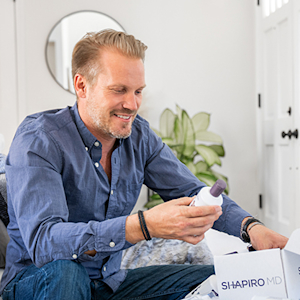5 Potential Ways To Speed Up Finasteride Results
2021-06-29
Finasteride is a 5-alpha-reductase inhibitor and is the only oral medication approved by the FDA for the treatment of hair loss. It's a powerful and proven solution for men with hair loss (and men only), but results can take time.
When ingested, the compound prevents the production of dihydrotestosterone (DHT), a sex hormone known to bind with receptors on hair follicles, leading to thinning hair and for many, baldness. By reducing the amount of circulating DHT in the body, finasteride can help to block this hormone from interacting negatively with hair follicles.
While progress with finasteride can take three to four months, maximum results can take up to a year. Despite the promise of an 86% success rate, many people don’t want to wait a full year to experience the benefits of treatment.
Here are five things you can try at home to speed up your finasteride results.
1. Regular Scalp Massage
Who knew massage could not only heal the body but potentially help with thinning hair? According to several studies, scalp massage has the potential to aid with hair thickness and growth. The process of massaging the scalp stimulates hair growth by dilating blood vessels to increase available oxygen, and it may increase hair thickness by stretching follicle cells.
While it seems unusual and a little too easy, massage is a promising and natural option for hair stimulation. When combined with the known benefits of finasteride, you might see quicker and richer results.
Tips and Techniques
A scalp massage is not much different from other types of massages, but it is typically gentler. When using a traditional technique without tools, use your fingertips, applying light or medium pressure and moving in small circles. You want to ensure you massage all areas you wish to see growth several times per day for a minimum of a few minutes each time.
Some dermatologists recommend using tools like a scalp massager or brush, but not all professionals feel such tools are essential. Whether you use a tool is a matter of personal preference and comfort.
While many traditional massages use oils, it’s unnecessary with a scalp massage, although some studies do suggest lavender and peppermint oil might promote hair growth. If you’re not allergic and wish to try, you can mix one or two drops of each oil with a single tablespoon of carrier oil, apply the mixture directly to your scalp, and work it in with a massager or your fingertips. It’s worth noting most studies showing promise with essential oils were focused on animals and not humans.
2. DHT Blocking Formulations
DHT, or dihydrotestosterone, is the hormone widely credited with hair loss in most men and women.
If your family has a history of hair loss, it could mean a genetic predisposition to the condition, which is the leading reason DHT binds to hair follicles. The hormone leads to follicle shrinkage, and over time results in thinning and baldness.
For people with a preexisting disposition to hair loss, it’s imperative to reduce or eliminate the connection or binding between the hormone DHT and the scalp's hair follicles. Using a DHT blocking shampoo may help interfere with the binding process, preventing hair loss.
Not all DHT fighting shampoos are created equal, but if you’re interested in trying one of these products in combination with finasteride, look for some of the following ingredients on the label, all of which have shown some ability to fight DHT in research:
- Saw palmetto
- Rosemary oil
- Biotin vitamins (Vitamins H, B7, or B8)
- Lavender oil
- Tea tree oil
- Pumpkin seed oil
- Ketoconazole
All of these ingredients have research supporting their DHT-combatting and scalp-benefitting effects. To receive the full benefits of these formulations, follow manufacturer directions and be sure to leave it on your scalp for a few minutes.
Be on the lookout for sulfur, synthetic chemicals, and parabens. These ingredients can lead to unwanted side effects or damage to your remaining hair.
3. Vitamin D
While many people understand vitamin D is essential to overall health and wellbeing, they misunderstand or completely underestimate its significance to hair growth and health. Vitamin D stimulates new and old hair follicles, promoting follicle growth and strength. Without enough vitamin D in your diet, hair loss can result. Low levels of vitamin D are not only linked to hair loss, but a deficiency can also result in other health issues, like bone softening, osteoarthritis, heart disease, and more.
If you’re experiencing spot baldness, consider talking to your doctor about vitamin D supplements. Increasing your vitamin intake to meet your daily needs could fight balding and promote faster and healthier hair growth with the finasteride treatment.
A supplement alone might not be enough. Most multivitamins only include 400 IU of vitamin D, which is below daily suggestions. You can get the vitamin in other ways, however, like through diet and outdoor activities. It’s not called the sunshine vitamin for no reason. You can often get your daily vitamin D requirement by spending a minimum of 15 to 20 minutes outside without sunscreen. If you cannot make it outside, try sitting near a sun-facing window.
You can also try eating more fatty fish and animal fats. Both food sources are rich in vitamin D as well as other health-promoting vitamins and minerals.
4. LLLT
LLLT, or low-level laser therapy, may increase circulation to the scalp and encourage hair growth by irradiating photons into the scalp tissues. Weaker cells absorb these photons, invigorating follicle health and function.
Unfortunately, LLLT is not effective for all people. However, several studies do point to the therapy as helpful. In combination with finasteride, the treatment may accelerate growth results.
There is little risk to trying LLLT. It is a non-invasive and painless process, with most devices cleared by the FDA. There are no side effects, and the treatment is proven to at least strengthen existing hair follicles. However, the process does take time, often requiring several treatments a week for months.
While LLLT is cleared for safe use by the FDA, it is not regulated by the same standards as medications. The preponderance of evidence suggests it can be beneficial as an additional tool for hair loss.
5. Minoxidil
Minoxidil is a topical solution used in the treatment of male pattern baldness. While primarily marketed toward men originally, the solution can promote hair growth in women, too. It is available as a foam or liquid that is typically applied twice per day: at up to a 5% concentration for men and 2% for women. While most scientists believe the drug helps increase the flow of nutrients and blood to the follicles, it’s mechanism is not perfectly understood.
What is known is that minoxidil can help regrow hair in most men and women.
You should not use this product if your hair loss is sudden or unexplained. Once you start using minoxidil, you may need to continue using it to maintain thicker hair.
If you choose to use minoxidil in combination with finasteride, make sure you follow directions for best results. While both products can take time to start working, you will typically see some benefit from minoxidil alone within four months.
Finasteride for hair loss is a leading therapeutic treatment for male pattern baldness. It’s useful in the reduction of DHT, limiting the effects of binding and weakening hair follicles.
While this treatment is backed by the American Hair Loss Association and decades of clinical use, many patients want faster benefits. The options above may be able to help speed up your recovery or regrowth process.
The experts at Shapiro MD are ready and willing to guide you through your hair growth journey, and the best part is, everything is done from home. As a leader in telemedicine, the Shapiro hair growth experts can help create a personalized hair treatment plan that works for you without ever seeing you in person.
Click here to get started with an online consultation today.


